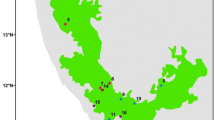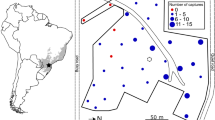Abstract
Predictions of ecological models on female social relationships (van Schaik 1989) and their links with food distribution and the potential competitive regime are used to analyze the feeding and spatial behavior, and resource density, size, distribution, and quality in a forest population of Hanuman langurs (Presbytis entellus). In contrast to other populations, and assumptions on folivorous primates, the females of this population exhibit a linear dominance hierarchy. The langurs concentrated their feeding on three key resources with a low density and clumped distribution. Two out of the three key resources contained significantly higher levels of extractable protein and soluble sugar than other food plants, indicating high spatial variability of food quality. Even the mature leaves of the most preferred food plant were about twice as nutritious as those from other food plants. Group spread was small and only a single high-quality resource was used at a time. Finally, even rich resources could accommodate only a subset of a group. These findings fit predictions made for the prevalence of within-group contest competition. Given the observed food distribution and phytochemical heterogeneity of mature foliage, even females of folivorous species should contest for food. The effect of female dominance rank on size and composition of feeding parties also agrees with this prediction. A comparison with data from another forest population, where female dominance relations are weakly developed, revealed a clear-cut difference in the use and abundance of resources. It is argued that between-population differences in female social relationships within a species may be viewed as adaptive responses to local habitat conditions.
Similar content being viewed by others
Author information
Authors and Affiliations
Additional information
Received: 1 August 1997 / Accepted after revision: 7 December 1997
Rights and permissions
About this article
Cite this article
Koenig, A., Beise, J., Chalise, M. et al. When females should contest for food – testing hypotheses about resource density, distribution, size, and quality with Hanuman langurs (Presbytis entellus). Behav Ecol Sociobiol 42, 225–237 (1998). https://doi.org/10.1007/s002650050434
Issue Date:
DOI: https://doi.org/10.1007/s002650050434




